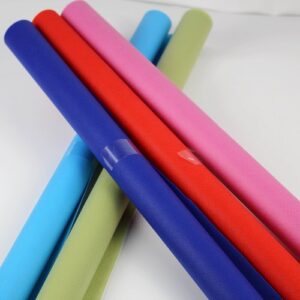Spunbond, meltblown, and needle-punched nonwoven fabrics are distinct types of nonwovens, each with unique characteristics derived from their manufacturing processes:
- Spunbond Nonwovens:
- Manufacturing Process: Created by extruding continuous filaments of a polymer and bonding them together. The process involves spinning and laying continuous filaments onto a conveyor, then bonding them through heat or chemicals.
- Characteristics: Spunbond fabrics are strong, durable, and have good tensile strength. They are resistant to tearing and abrasion.
- Properties: Typically have a smooth surface, offer excellent breathability, and are commonly used in applications requiring strength and stability, such as geotextiles, packaging, and disposable clothing.
- Meltblown Nonwovens:
- Manufacturing Process: Formed by blowing molten polymer through fine nozzles, creating microfibers that are collected and bonded together using heat or pressure.
- Characteristics: Meltblown fabrics have extremely fine fibers, creating a web with a very small pore size. This results in excellent filtration properties and a soft texture.
- Properties: Highly efficient at capturing small particles, used extensively in filtration applications such as air and liquid filtration, medical masks, and protective apparel.
- Needle-punched Nonwovens:
- Manufacturing Process: Produced by mechanically entangling fibers using barbed needles. The fibers are pushed through a base material, intertwining and bonding as the needles punch through.
- Characteristics: Needle-punched fabrics are strong, durable, and have a fibrous texture. They can have varying thicknesses and densities.
- Properties: Known for their high tensile strength, resistance to tearing, and good dimensional stability. Commonly used in carpets, China nonwoven fabric manufacturer geotextiles, automotive interiors, and insulation applications.
While all three types are nonwoven fabrics, their manufacturing processes and resulting properties vary significantly, making them suitable for diverse applications across industries based on their specific characteristics and functionalities.
How does nonwoven fabric contribute to innovation in industries such as healthcare or automotive?
Nonwoven fabrics play a crucial role in driving innovation in various industries, including healthcare and automotive, due to their unique properties and versatile applications:
- Healthcare Industry:
- Medical Textiles: Nonwoven fabrics are extensively used in medical textiles for applications such as surgical gowns, masks, drapes, wound dressings, and disposable medical supplies. They offer properties like breathability, barrier protection, absorbency, and comfort, meeting stringent hygiene standards and ensuring patient safety.
- Infection Prevention: Innovative nonwoven materials with antimicrobial properties or specialized coatings help prevent infections by reducing the growth of microorganisms on surfaces, aiding in healthcare-associated infection control.
- Wound Care: Advanced nonwoven materials designed for wound dressings provide optimal moisture management, protection from external contaminants, and support for the healing process.
- Automotive Industry:
- Interior Applications: Nonwoven fabrics are used in automotive interiors for headliners, upholstery, carpets, and insulation due to their durability, noise reduction properties, and ease of installation. Innovations in nonwovens offer improved comfort, aesthetics, and weight reduction in vehicles.
- Filtration Systems: Nonwoven materials with enhanced filtration capabilities are utilized in automotive filtration systems, including air filters, fuel filters, and cabin air filters. These innovative fabrics contribute to improved air quality and engine performance.
- Composite Materials: Nonwoven fabrics are integrated into composite materials used for structural components, providing strength, impact resistance, and weight reduction in automotive manufacturing.
In both healthcare and automotive sectors, ongoing research and development efforts focus on creating specialized nonwoven materials tailored to meet specific industry needs. These innovations lead to the development of high-performance fabrics, improved functionalities, enhanced safety standards, and more sustainable solutions. Nonwoven fabrics continue to be at the forefront of innovation, driving advancements in diverse applications within these industries.
